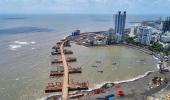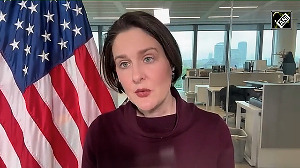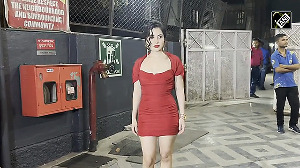'You need to have enough funds to maintain the primacy of public transport and it should not suffer because of lack of funds.'

Prime Minister Narendra Damodardas Modi will inaugurate India's longest (21.8 km) sea bridge on Friday, January 12, 2024,, a crucial infra project that promises to change the lives of many people living in the Mumbai Metropolitan Region (extended Mumbai).
Constructed at a cost of Rs 17,843 crore (Rs 178.43 billion), the MTHL connects Sewri in central Mumbai to Chirle in Navi Mumbai, saving more than an hour in commute time, and is expected to cater to 70,000 vehicles daily.
The bridge will be known as Atal Setu, after the late prime minister Atal Bihari Vajpayee.
It will make it easier for people living in central and south Mumbai to connect to Panvel area and also the upcoming Navi Mumbai international airport.
But what is bothering many people is the steep cost of Rs 250 one-way toll that the Maharashtra government has proposed to charge car owners which, it is felt, may deter the public from using the direct connector to Navi Mumbai.
Syed Firdaus Ashraf/Rediff.com spoke to mobility solutions proposer Sudhir Badami on what he thinks about the project, the toll and how the bridge will benefit Mumbaikars.
How will the MTHL transform the lives of Mumbaikars?
The Mumbai you say is Greater Mumbai, or is it Mumbai Metropolitan Region? In that case we need to call it the Mumbai Metropolitan Region or MMR.
People staying in the hinterlands of Mumbai will be coming to Mumbai (via the MTHL) because it will be affordable for them to stay over there (in Navi Mumbai-Panvel region) and travel 25 km (or more) to the Mumbai Island City for employment and go back to their homes. They will be commuting, and this will help them.
In the same way, people from South Mumbai or living in the Island City of Mumbai can go to Navi Mumbai for work in offices or manufacturing factories located over that side of the MTHL. There will be an exchange of traffic from this side and that side. The number of people at present traveling daily to and from is not known yet and this calculation will come from MMRDA.
Isn't Rs 250 as one-way toll too expensive to cross the MTHL? Many people are complaining about the price factor.
The way to compute the toll is to recover the amount (spent on the project) in 25-30 years. And the loan amount taken has to be paid along with interest (and recovering the amount spent by MMRDA) for the construction of the MTHL.
The cashflow operation has been done by the consultants appointed by MMRDA. They came with four norms on how to charge for toll. The Maharashtra government has its own norms for charging toll. The National Highway Authority of India has its own norms. Bandra-Worli Sea Link has its own norms and the Samruddhi (Mahamarg) Expressway (Mumbai-Nagpur) has its norms. They have certain methods on which they calculated the toll and they are varied somewhat.
The base price for cars was the lowest from the Maharashtra government and it was the highest from the Bandra-Worli Sea link. And if you check the Bandra-Worli sea link base price for MTHL, it would have been Rs 390 per trip.
If the Maharashtra government norms were accepted it would have been to Rs 245 per trip. Finally, they settled for Rs 250 per trip, but I feel the toll for per trip for cars should have been Rs 500 on MTHL with no rebates for multiple use.
You suggested more than what is proposed to be charged!
Yes, because there is logic. I suggested to charge more for cars and the Maharashtra government should make a categorical statement that they are making public transport priority number one.
You need to have enough funds to maintain the primacy of public transport and it should not suffer because of lack of funds. And therefore, I suggested to charge Rs 500 for car per trip on MTHL. I also suggested zero toll for public transport buses with capacity of 10 seats and more.
At this moment we do not know whether the Bus Rapid Transit System (BRTS) will run on the MTHL for the public and since Rs 250 is a high charge for one way toll, do you fear that the bridge can be under-utilised?
Even if you make Rs 500 toll per trip for cars on MTHL it will not be under-utilised in terms of traffic. It is because the people who use cars value time. They feel they are unproductive to sit in traffic jams and rather be somewhere else and be more productive. It is time saved and energy saved as travelling for long also exhausts you.
The middle income people may not be able to pay and therefore I am saying we need to have good quality public transport upfront on MTHL. All these things need to be properly planned. I have written a paper on this.

Can you give some details from your paper?
It is called 'Making commuting in Mumbai enviable'. It covers a lot of ground. I have highlighted six points in the paper.
Firstly, it will attract 60 to 65% of personal car users to the Premium Public Transport System provided in the form of premium BRTS and premium aggregator taxis.
Secondly, it will improve peak hour speed of road traffic to 30 kmph from the measly 10 kmph.
Thirdly, it proposes to charge personal car users for using and congesting a decongested road to prevent re-congesting.
Fourthly, provide high capacity of road public transport through provision of normal BRTS squeezed in between the premium BRTS on the same routes and fully meet the demand gap not met by Metro rail projects.
Fifthly, it proposes to provide high frequency microbus stage carrier service that will be universally accessible, catering to the needs of persons with disabilities such as the elderly, pregnant women, the infirm, a ten year old besides the wheelchair user, the frequency being just high enough that there will be practically no waiting time spent by the commuter anywhere in the transport system.
Finally, boarding and alighting the public transport system will pose no danger to life or limb.
The cost of high frequency microbus stage carrier service is not much. If we can afford the (expensive) metro we can very well afford this too.
Many people say it would have been better had a rail track been built at the same place over the sea instead of the MTHL which will cater mostly to wealthy people. What is your opinion?
Originally, there was a plan for railway tracks also. This was 20 years ago, but cost considerations came in (and the plan was dropped).
The metros have taken off because the economy has picked up tremendously in the last 15 years. Therefore, money is available and construction is going on metro lines like Line number 4 of LBS Marg. On other phases of the metro the construction is in lull or in low construction mode. Right now on JVLR where I live, I see no construction of metro (Line #6) happening for more than a year now.
Despite being an island city do you feel we never thought of a water transport system? Was it not feasible?
If something is feasible in Mumbai, then we are a very enterprising people who will enter the field even before the government enters the services. But the problem for not having water transport in Mumbai is that we have a lot of (exposed) rocks in the sea on the west coast which is close to the shore. This means that you have to take a jetty two or three km into the sea to reach your service (water transport). And after that you have to see, what is the capacity that water transport can offer.
The railways offers 180,000 persons to travel from North to South per hour. And it takes a load of 360,000 persons per hour. This additional 180,000 persons have to be accommodated and here the metro comes into the picture.
Before the metro project took off I was advocating BRTS. It had to be properly designed and BEST could have taken up the project with lot of detailing for people to look at BRTS positively. And in my opinion the metro lobby says that BRTS is a failure, which is not right as in Pune they had been appreciated.
Though they have dismantled it in Pune recently and are contemplating dismantling BRTS in Bhopal, Jaipur etc, just to sustain the metro. There is a politics of metro versus BRTS.
In Surat BRTS is successful, if I am not mistaken.
Yes, BRTS is a success in Surat, Rajkot and Ahmedabad, not to forget in Indore too. The only thing is that its success is limited because of their low capacities matching the low needs unlike what is needed for Mumbai.
In Mumbai when I did the analysis I envisioned four routes for which capacity would be 50,000 people travelling per hour on each route. It means 200,000 passengers per hour. This would have helped to curtail the load of 180,000 extra commuters on the railways.
The other option I had envisioned was six routes for BRTS with 30,000 passengers per hour. Prima facie, there was a possibility but they (the government) did not take up the project seriously because the metro lobby prevailed. And the metro project could not start till 2015 and it started later because of anticipated funding from the central government and property registration tax.
The Metro Line#3 project, which is an underground metro project, was only under planning in 2011. It was substantially funded by JICA (Japan International Cooperation Agency) in 2015 .
Is that the reason why water transport could not pick up in Mumbai because transporting 1.8 lakh people an hour is not practical and also rocks in the sea made the project unfeasible?
Yes, because you had to travel right in (to the jetty). This was not restricted to one particular place in the sea but acrossMumbai's western seashore. You go to the lighthouse at Colaba tip (south Mumbai) and you see rocks. It is only in the bay area of Mumbai that you do not see rocks, but there are some though. In the Churchgate area (south Mumbai) you can see rocks when you go near the sea during low tides. In Bandra (north west Mumbai)too you will see rocks besides the sea when there is low tide.
On the east coast of Mumbai you have depth in the sea, but then you have the docks over there. Moreover, there is no commercial or residential activity going on over there so that too has not developed there.
It was said in the 1880s that decongestion of New York city would begin when the Brooklyn Bridge was built. More than 100 years later you don't see that happening in New York in terms of traffic jams. So in what way will MTHL change the life of Mumbaikars as far as decongestion of the city is concerned?
The density of population is very high in Mumbai city. If you see the island part of the city, south of Mahim-Chunabhati the density is 460 persons per hectare. It is very high.
The small Ward C (Bhuleshwar-Chira Bazar area) of Mumbai is 1,100 persons per hectare.
But the population in South Mumbai has slightly decreased from 33 lakhs to 30 lakhs (3.3 million to 3 million). In Mumbai's eastern and western suburbs the population density is high at 320 persons per hectare. This includes the national park area which is 103 sq km.
If you remove this area, then Mumbai suburbs' density will be 360 persons per hectare or a little higher. And the government pushes their agenda by stating the metro will deliver, which people believe, but then as citizens we must wonder why should we wait till 2041.
When I was campaigning for BRTS (in the first decade of this millenium), MMRDA did carry out a study (for the Western Express and Eastern Express Highways), but the metro lobby prevailed.
People want to have a metro kind of luxury and they cannot imagine they can have the same luxury (and delivery) in buses too. We need to get premium BRTS to get cars out of roads.
And to ensure that, you need to charge congestion tax. Car users may say that it is an unfair tax on them, but then we are providing almost equivalent luxury (and delivery) under BRTS.
So to avoid this we can bring in a BRTS premium service which has business class seating like an airline and then first class sitting arrangement and then economy class.
Which city has successfully implemented BRTS?
The pioneer is Bogota in Colombia. BRTS in Bogota carries 45,000 people per hour. They arrived at the decision to go for BRTS because they had no money to build metro trains, opting for socially relevant initiatives with available funds.
Constructing metro line is 10 times more (costlier) than constructing BRTS. And if you consider constructing underground metro then it is 20 times more expensive.
The government, when they speak of constructing metro, they only speak in terms of sustainable, environmental issues like they don't burn fuel and the government says their operation expenses are covered. They do not talk about the huge investments they put into the metro project that needs to be recovered. Therefore, there is always a shortage of funds felt to provide for socially relevant initiatives.
And who is paying for this huge investment for metro? People who have low incomes, and they are in large numbers in our country. Their income goes in sustaining metros. And the metro is used by people who travel by first class in the railways.
The whole thing is lopsided as we are not giving respect to our Constitution. We have to respect our Constitution by planning accordingly and giving benefits to everybody.











 © 2025
© 2025